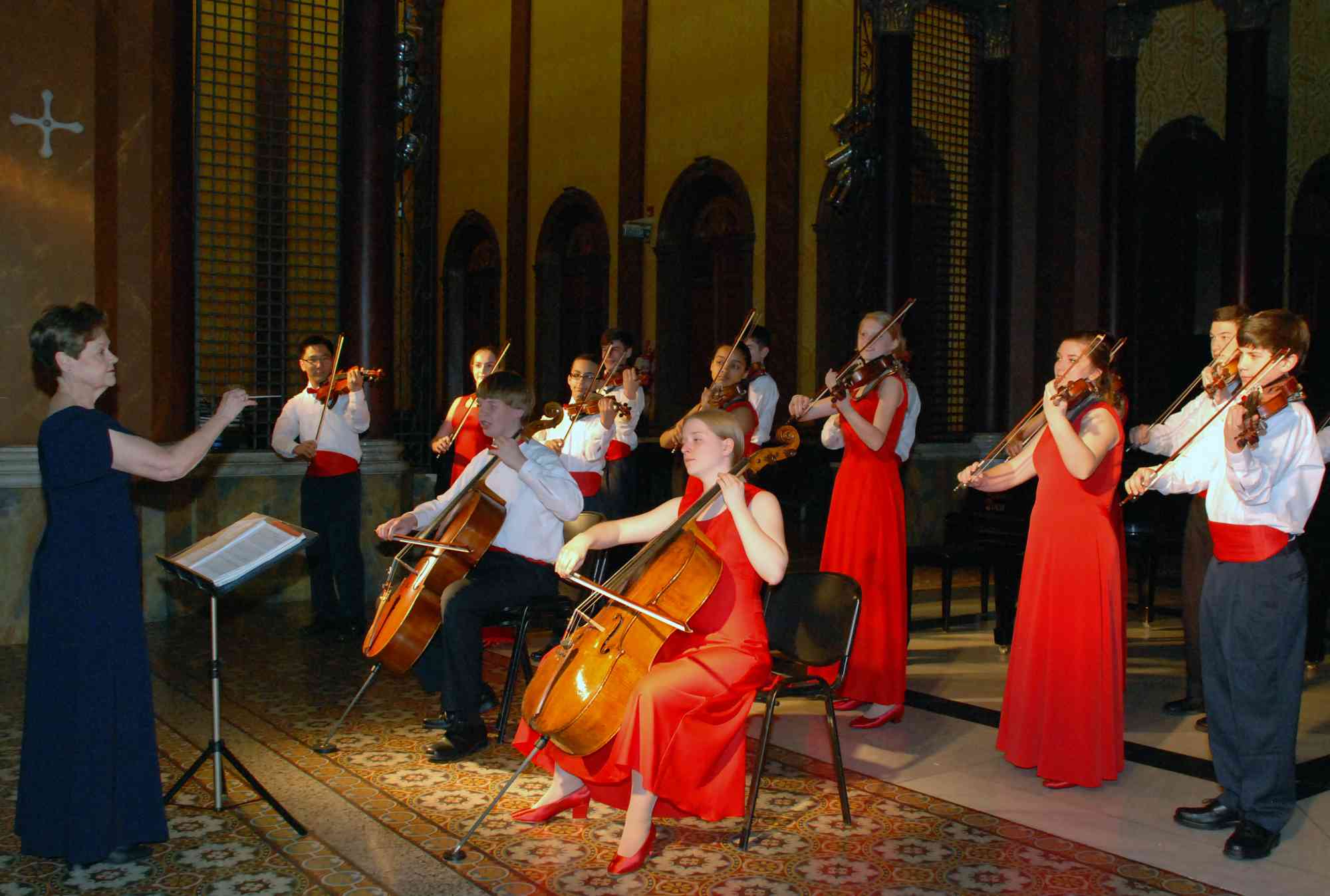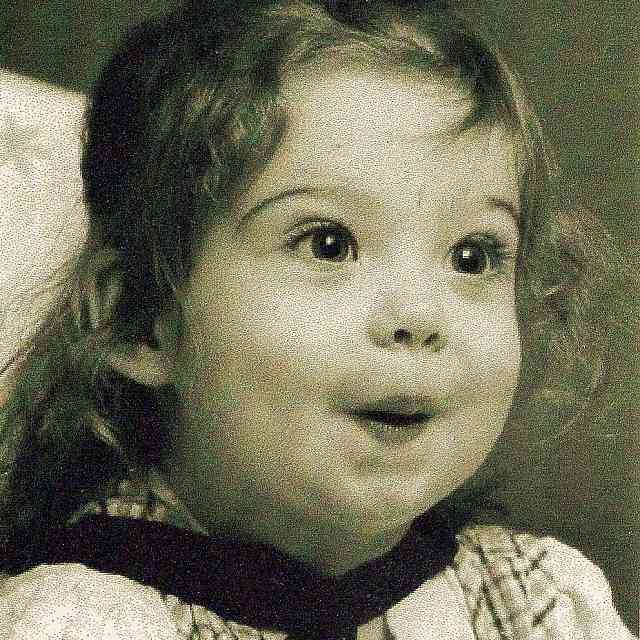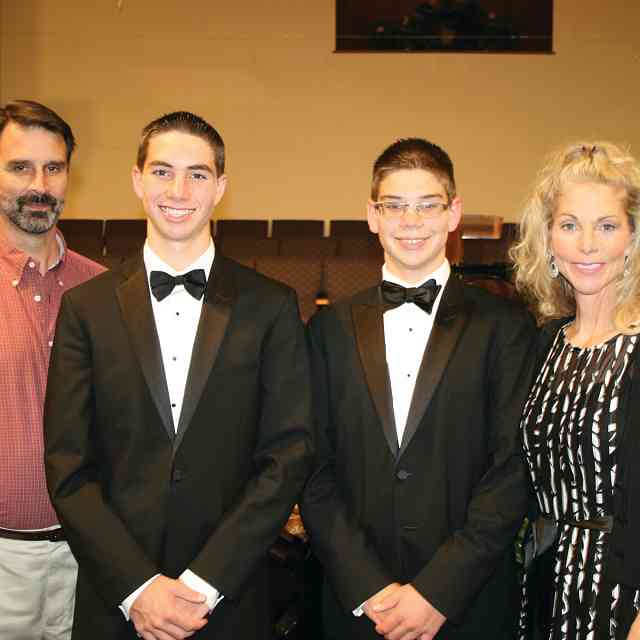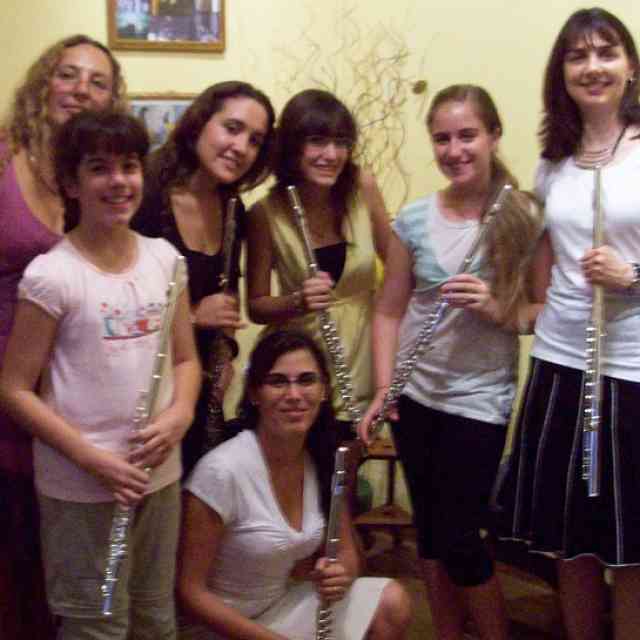I could not see the wand or wizards who must have been hiding nearby, but the spell that was cast was unmistakable. Somewhere in Argentina—or perhaps before we even left Buffalo—we were bewitched.
We were transformed from a group of talented, well-trained, and dedicated Suzuki students into an ensemble of passionate musicians. We were transformed from a group of proud Buffalonians to equally proud citizens of a much larger world. We were forever changed and became fluent in the universal language of music and friendship. The changes are undeniable and indelible.
On April 15, 2011, the Buffalo Suzuki Strings (BSS) Friendship Touring Ensemble began a magical journey unlike any other we would take in our lives. We embarked on a tour to Argentina, led by our director, Mary Cay Neal, who has been teaching and living the Suzuki method for more than forty years. Inspired by Dr. Suzuki’s dream of World Harmony Through Music, since 1984 the BSS Friendship Touring Ensemble has strived to make his dream a reality. The Friendship Touring Ensemble has traveled to five continents and visited twenty-two countries including England, USSR, Italy, Chile, Australia, Brazil, and Japan. The seeds for this particular musical tour began two years ago in Minneapolis at the Suzuki Association of the Americas Conference, where one of the Buffalo Suzuki Strings students, who happened to be my younger brother, Mandela, was part of quartet with two girls from Argentina. That connection created a spark that ignited a fantastic dream… Wouldn’t it be great if…? Through the magic of the internet and Suzuki connections, we were able to connect with two amazing and veteran Suzuki teachers in Argentina, Fernando Piñero and Eduardo Ludueña, who invited us to visit with and perform for their Suzuki programs. Once those connections were made, Mrs. Neal began searching for just the right music. She decided that the musical program would include the amazing Tango: Por Una Cabeza (Carlos Gardel), an Argentinean standard, and, of course, the BSS signature piece that we have played on almost every continent in the world, Orange Blossom Special (traditional).
There were many months of planning and preparation for this tour, including numerous extra rehearsals, tour dinners, and educational presentations. It was a complete group effort that involved the Suzuki Triangle of teachers, students and parents. For the final four weeks before the tour commenced, after every rehearsal, the parents made dinners for us and then presented educational sessions so that we would better understand and appreciate Argentina and its culture and customs. One of the most unforgettable sessions was a talk by a local Argentinian couple who shared the love they had for their country with us. Hearing their stories made us all so excited for what was to come. The dinners were equally important because our parents joined into the spirit of Argentina by recreating some traditional Argentinian dishes. They were all so delicious! The process of preparation not only brought the Touring Ensemble closer together, but it made our parents more of a unit, too. We worked so hard to prepare and it seemed as if the day of departure would never come.
Our trip began and ended at the Buffalo Suzuki Strings Musical Arts Center in North Tonawanda, NY. That building is our second home and where we rehearse, help teach the younger students, and even have sleepovers and other social events. For the twenty-one students ages eleven to eighteen and four chaperones/teachers, the adventure began on that early Friday morning in April, although we would not land in Argentina until late the next morning. Because our travel plans required that we take a bus to Toronto in order to make our connection to New York City, our trip involved traveling in four countries (Canada, United States, Chile, and Argentina). Some students had never even been on a plane before, while Mrs. Neal has traveled all over the world in the name of Dr. Suzuki. Those of us who had been on international tours before with BSS and other more experienced travelers made sure to reassure and support the unseasoned travelers with hugs, smiles, and other distractions. The magic had already begun.
Our first stop in Argentina was Córdoba, a wonderful city about the size of Phoenix, AZ. It was there that our true exchange experience began. An unexpected yet delightful surprise was awaiting us. Fernando Piñero, the director of the Córdoba Suzuki program Escuela de Música Shinichi Suzuki de Córdoba, made a special trip to the airport just to greet us! He made us each feel so welcome from the moment we set foot in Argentina, which was wonderful foreshadowing for the hospitality we would experience for our entire trip. We were exhausted and excited all at the same time. After we checked into our hotel, we went to spend time with our Suzuki hosts in Córdoba. As we walked off the bus, the students came out of the building and greeted each of us with a hug and a kiss on each cheek, a custom I found so much more welcoming and intimate than the traditional American handshake. That was our first instance of cross-cultural exchange, where we learned to adapt and appreciate the culture of another. Most of us embraced their openness from the beginning but for others it took a little longer. After a few brief introductions to meet students, parents, and teachers, we took out our instruments and performed one or two pieces. Of course, that was immediately followed by a Suzuki play-in. There is nothing quite like the feeling you get when you play music with someone else. It’s not just the lyrical connection of sounds, but also an actual intertwining of souls. In many cases, you can learn as much about others from watching their vibrato as you can from talking with them for hours. Even those of us who were less proficient in Spanish still felt a profound connection to the students from Fernando’s school in Córdoba after we played even the simplest songs of the Suzuki repertoire with them. An amazing feast prepared by the parents of the Córdoba students topped off our musical experience. The meal was delicious and exciting, complete with new foods and tastes. After the meal, Fernando organized a series of games for all of us to play that would cement our budding relationships. Even with the language barrier, playing games, such as building a tower of shoes, untangling people from a web of string, and going on a scavenger hunt, seemed effortless. The highlight of the night was a rousing game of Quackadilly-Oh-My that had everyone involved either playing or cheering and by the end we were all roaring with laughter. We went back to our hotel exhausted but knowing that after just a few short hours in Córdoba, we had already made friends.
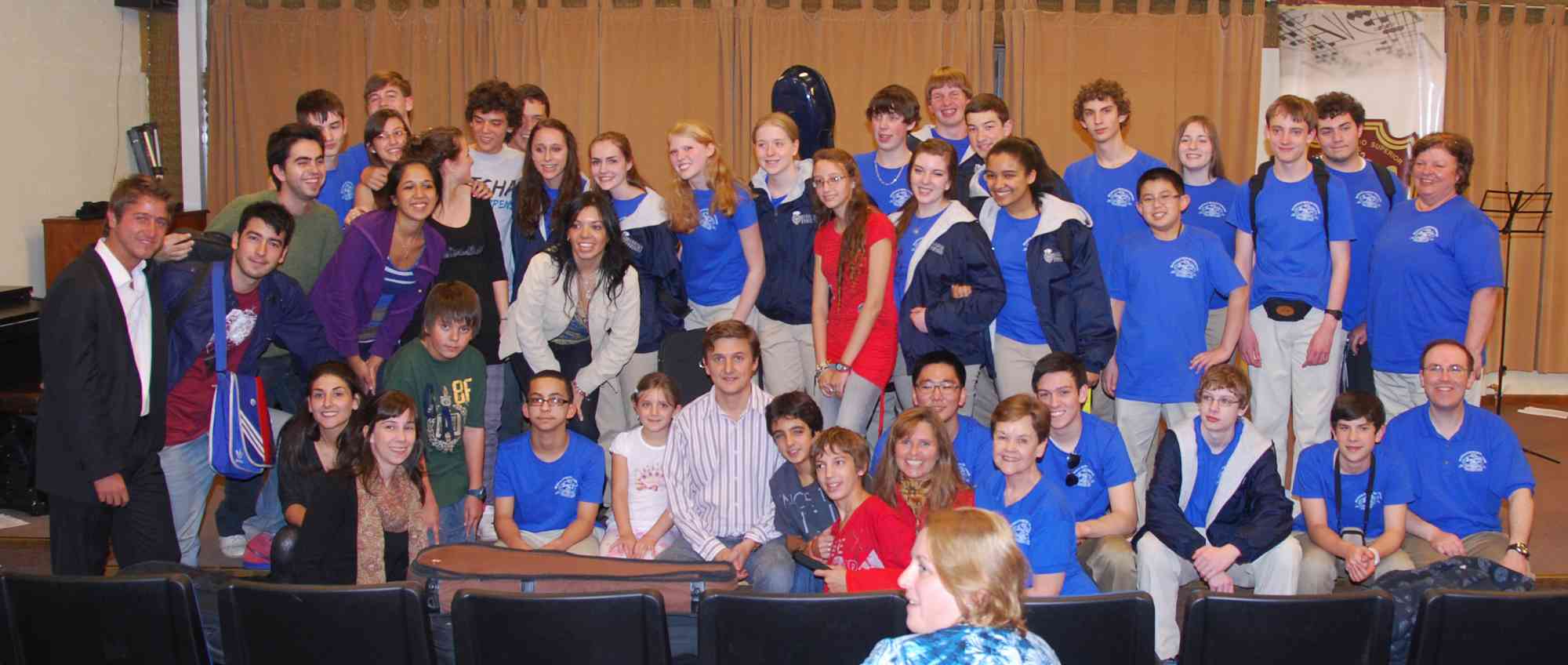
From Cordoba and Buffalo, new friends
Our trip to Córdoba involved sightseeing and the opportunity to visit the countryside. The entire country of Argentina has a marvelous history, and everywhere we went, people shared stories and memories. While in the city, we visited many places, including Plaza San Martin, the Cathedral, El Cabildo, Compañía, Manzana de las Luces, and the Universidad Nacional de Córdoba. More than anything else, we loved just walking around watching people in this beautiful city. Our group also visited the quaint village of Alta Gracia in the nearby countryside that had a rich history of its own. While there we visited the home, now a museum, of the famous composer Manuel de Falla. The guide in the museum was very proud and informative and when he discovered that we were a group of classical musicians; he unlocked de Falla’s piano and allowed our piano students to play on it! What an incredible and unforgettable experience.
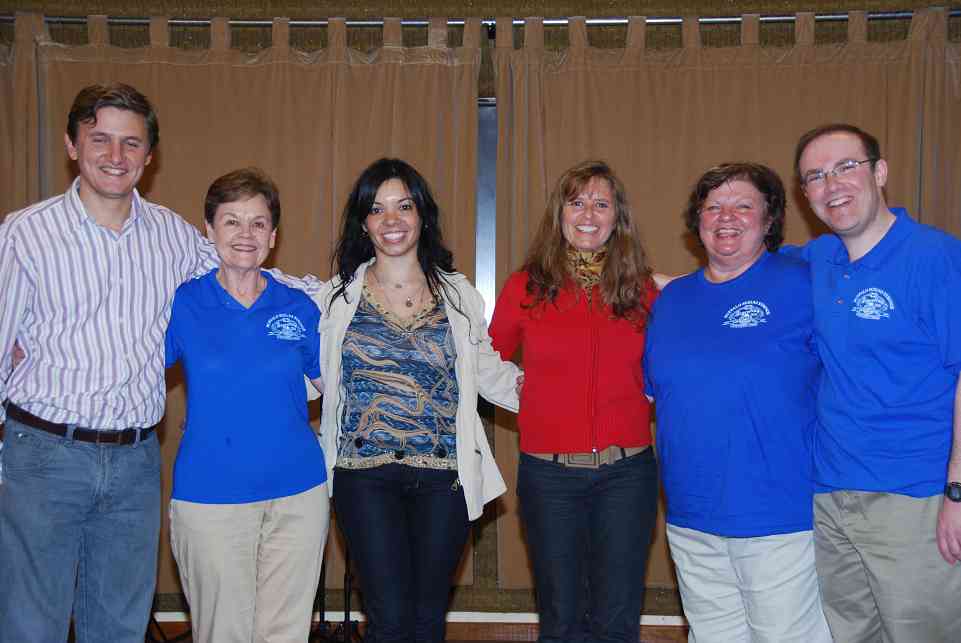
Suzuki Workshop in Cordoba: Fernando Pinero, Mary Cay Neal, David Levine and colleagues
Over our four days in Córdoba, we spent considerable time with the students from Fernando’s program and each occasion brought us closer. It became easier to understand each other, we laughed more and we fully embraced the goal of our trip: “World harmony through music.” While there, Mrs. Neal conducted teacher training workshops, and Mr. David Levine, Assistant Music Director of BSS, offered a workshop for teachers on teaching multilevel Suzuki groups. Since Mrs. Neal is a violin teacher trainer who studied with Dr. Suzuki for many years, the teachers were eager to hear her speak about Dr. Suzuki’s methods and philosophy. Mr. Levine spoke about creatively teaching multi-level group classes which he has had much experience doing at Buffalo Suzuki Strings. In addition to the work they did with teachers, both Mrs. Neal and Mr. Levine taught lessons and group classes for the students in the Escuela de Música Shinichi Suzuki de Córdoba.
Our trip to Córdoba culminated in a concert where we performed our music in love and friendship. This concert was truly magical. The venue was the beautiful Capilla del Buen Pastor and did much to inspire our playing. In this packed concert hall, we played our best, better than we knew we could. As people congratulated us, our teachers included, we were told that we played with energy, clarity, passion, and sensitivity. And we knew it; we could feel it and it spurred us on! One of our favorite parts of the concert was when the Suzuki students from Escuela de Música Shinichi Suzuki de Córdoba and their teachers joined us for a classic Suzuki play down. The sound echoed throughout the hall reminding us of the power of music. After the concert, we and many of the older Córdoba students and teachers walked to a local restaurant and shared a meal one last time. The time together was wonderful! We ate, laughed, and exchanged email and Facebook addresses. We were friends now. I, for one, began to dream of the possibility of our new Córdoba friends traveling to the United States to see us so that we could share our country and our culture with them.
The second phase of our trip began with another plane ride, a short hop from Córdoba to Buenos Aires. They call Buenos Aires the Paris of South America, and I certainly understood why as soon as I saw it. It had the same “big city” feel as New York City and Toronto, and it also had a rich and varied history. From the Casa Rosada (Pink House—the official seat of the executive branch of their government, much like the American White House), Plaza de Mayo, The National Congress Hall, and the artists’ district of La Boca, the history and culture is so apparent and visible on every corner. Buenos Aires is a thriving city that combines the old and the new in an explosion of culture. From the waterfront to a huge squatter community, it is a place unlike any other I’d seen.
On our first night in Buenos Aires, before we even had a chance to meet the students from Centro Suzuki Buenos Aires, we went to a tango dinner and show, which was an absolutely phenomenal experience! The show didn’t begin until 10 p.m., but despite our exhaustion, we found ourselves mesmerized. While we had been playing a Tango for many months and even had one Tango lesson in Buffalo before leaving on the tour, we realized we had barely begun to grasp the Tango in terms of its beauty and significance for the Argentina culture. The men and women switched partners and rapidly moved on and off stage in a beautiful dance of art and passion. Tango dancing, in many ways, is like playing a musical instrument. Neither of them can be performed properly without intense emotion and passion. The beauty of Tango music and dance paralleled that of any type of musical instrument I’ve ever heard.
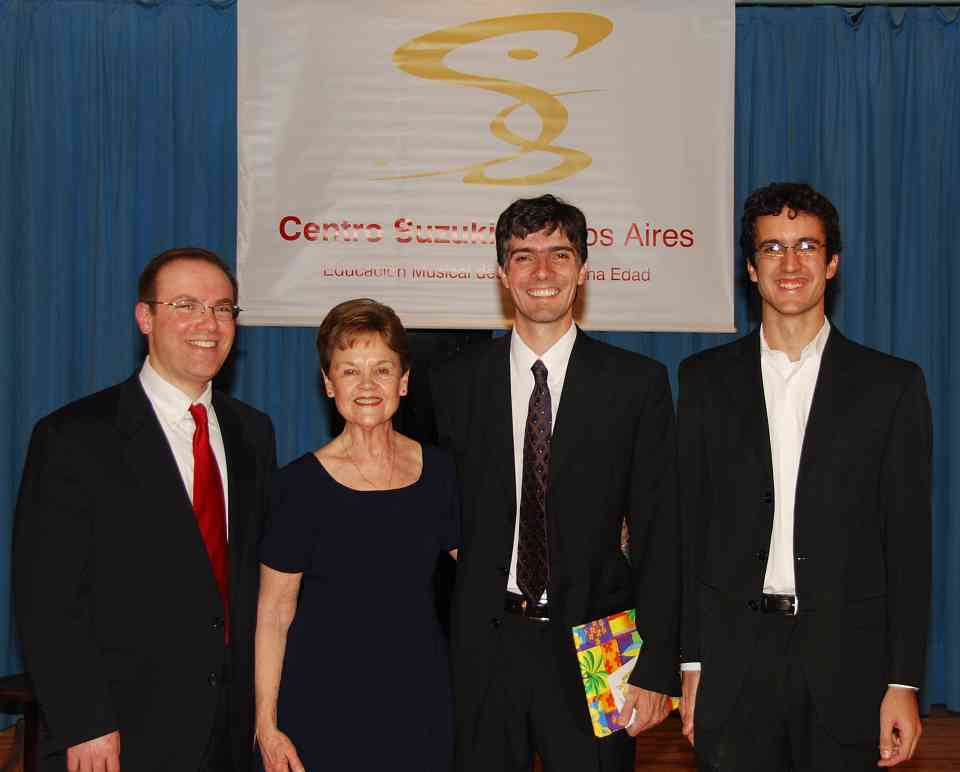
Playing our music together in Buenos Aires: David Levine, Mary Cay Neal, Eduardo Luduena, and Joaquin Chiban
The next day, after additional touring of Buenos Aires, we were excited to meet the students from the Centro Suzuki Buenos Aires and its director, Eduardo Ludueña. It didn’t take long for us to make great connections again. This time, although the students were much younger than us, we still were able to make great music with them. We had a play-in and Mrs. Neal and Mr. Levine again conducted training and workshops for teachers and provided lessons and group classes for students. Later that evening we had the chance to celebrate Mrs. Neal’s birthday. At dinner, even though we hadn’t planned it this way, one by one we lined up to give her a birthday card and a kiss on the cheek—we were so inspired by Argentinian culture! That birthday line was such a testament to what she means to each and every one of us.
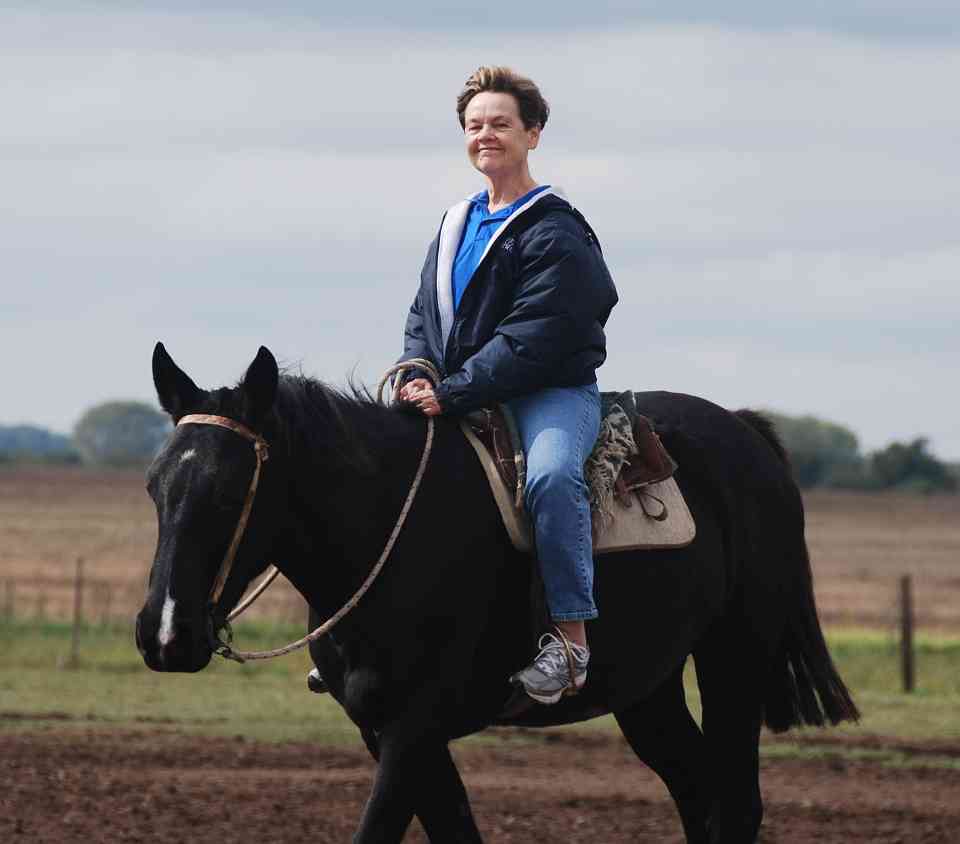
Our fearless leader, Mary Cay Neal!
In Buenos Aires, we had many interesting experiences. We took a one-day excursion to an estancia, much like an American ranch, where we all rode horses and watched another Tango dance show as we ate delicious beef, chicken, and fish they had grilled for us. They also had a little store there with hats and slippers and scarves and many other leather goods. Later that evening, when we arrived back in Buenos Aires, we had a private workshop with a local Argentinian violinist, who taught us even more about playing the Tango and its importance to Argentina.
Before heading back home, there was one last memorable concert. As we played on that stage, I could feel how our time in Argentina influenced and shaped our music and us as musicians. We played in unison, speaking with one voice, brought about through an incredibly bonding experience. The transformation was complete. We were musicians! On Sunday morning, our last day, we attended Easter mass at a local church, where we had some quiet time to reflect on our journey and be grateful for this experience. Afterwards, we packed up to leave and we stopped off for one last delicious Argentinean meal at a nearby restaurant. Then it was back to the airport and the long journey home.
Returning home, although welcome after ten days away, was not easy and I don’t just mean the travel. There was so much to incorporate and understand from this experience, and even two days of travel did not seem like enough time. I know I grew as a person and a musician on this tour, not only because of the people I interacted with, but also through my interaction with a foreign culture, very different from my culture in every way. Traveling to a new country, even a new continent in this case, is quite an eye-opening experience, and can make even the most stereotypical American conscious of the world’s diversity. I know it is not just me; we were all transformed by our tour to Argentina. This fall, as we began a new musical year at BSS, I can see and hear it as I listen to my fellow students. We sound better and are even more committed to our music. We have grown as musicians and as people. We have been transformed—bewitched, if you will. The changes are undeniable and indelible.
